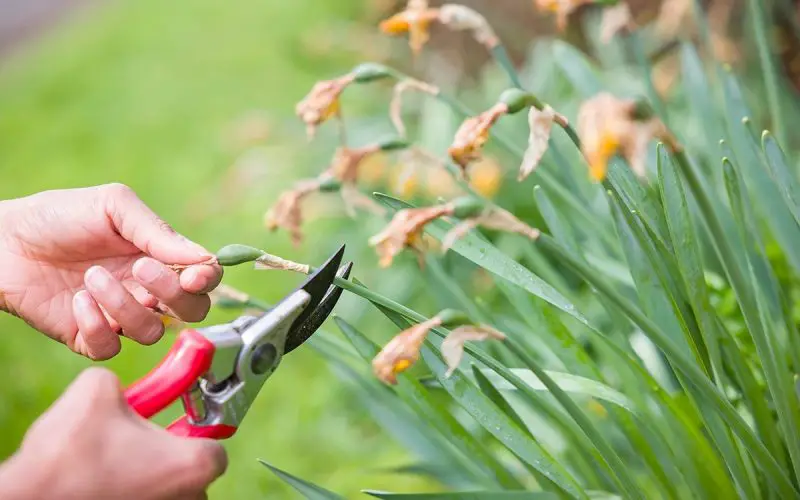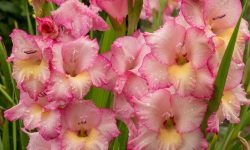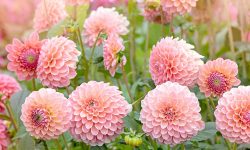Daffodils are among the most iconic symbols of spring, brightening gardens with their cheerful yellow, white, and orange blooms. These resilient perennials are loved not only for their beauty but also for their reliability, returning year after year when properly cared for. However, if you want your daffodils to continue producing strong and vibrant flowers, deadheading plays a crucial role in their maintenance.
Deadheading is the process of removing faded or spent flowers to redirect energy back into the bulb rather than seed production. Many gardeners overlook this step, assuming daffodils will thrive naturally. While they are indeed low-maintenance, removing old blooms significantly boosts the bulb’s strength, resulting in healthier plants and more impressive displays in future seasons.
This detailed guide will explain why deadheading is essential, when and how to do it correctly, and what additional care steps can make a big difference in encouraging daffodils to bloom more vibrantly every year.
Why Deadheading Daffodils Is Essential for Healthy Bulbs

Deadheading daffodils is more than just a way to keep your garden looking neat. It directly affects the plant’s energy distribution. Once a daffodil flower fades, the plant instinctively tries to produce seeds, which consumes valuable energy. For gardeners who are not interested in growing daffodils from seed, this energy expenditure is unnecessary and even detrimental.
By removing the faded flowers promptly, you allow the plant to redirect its resources into strengthening the bulb. A stronger bulb not only ensures more vibrant blooms but also increases the bulb’s lifespan, making it capable of producing flowers for many years. Over time, consistent deadheading can lead to larger bulbs that multiply more effectively, creating thick, colorful clumps in your garden.
Additionally, deadheading helps maintain garden aesthetics. Wilted flowers and seed pods can look messy, taking away from the beauty of spring borders. By removing these faded blooms, your garden remains visually appealing even after the main flowering season. Deadheading also reduces the risk of fungal infections that may develop on decaying flower parts, keeping the plants healthier overall.
The Best Time to Deadhead Daffodils
Timing is crucial when it comes to deadheading daffodils. You should remove spent blooms as soon as the petals begin to wither and lose their vibrant color. The earlier you stop seed production, the more energy is conserved for the bulb. Depending on your climate and daffodil variety, this typically occurs two to three weeks after the peak bloom period.
However, while deadheading should be done promptly, you should never remove the leaves too early. The foliage continues to photosynthesize long after the flowers have faded, storing energy in the bulb for next season’s growth. Removing or tying up the leaves prematurely can severely weaken the bulb, leading to fewer and smaller flowers in the next bloom cycle.
A good rule of thumb is to allow the leaves to remain until they naturally turn yellow and begin to wither. This process can take four to six weeks, depending on environmental conditions. Patience is key; the longer the foliage stays healthy and green, the better the bulb will recharge for the next season.
How to Deadhead Daffodils Correctly
Deadheading daffodils is simple, but doing it incorrectly can harm the plant. Begin by identifying flowers that have completely faded. Hold the stem just below the flower head and use clean, sharp garden scissors or pruners to snip off the spent bloom, including the seed pod. If you prefer, you can also pinch off the flower head with your fingers, but ensure you do not damage the stem or leaves.
Some gardeners choose to remove only the flower head, leaving the stalk intact, while others cut the entire flower stalk down to the base. Both methods are acceptable as long as the leaves remain undisturbed. The primary goal is to prevent seed formation while allowing the plant to continue photosynthesizing.
Always sterilize your cutting tools before use to reduce the risk of spreading diseases. After removing the faded blooms, discard them rather than leaving them on the soil, as decomposing flowers can attract pests or fungal infections.
Caring for Daffodils After Deadheading
Deadheading alone is not enough to ensure vibrant flowers next season. Proper aftercare plays a significant role in keeping bulbs strong and healthy. Once you’ve removed the spent blooms, focus on maintaining healthy foliage. Continue watering the plants during dry spells, keeping the soil evenly moist but not waterlogged. Excess water can cause bulb rot, especially in heavy soils, so ensure good drainage.
Fertilizing after deadheading is also beneficial. Use a balanced, slow-release fertilizer or one specifically formulated for bulbs. Fertilizers high in phosphorus and potassium help strengthen the bulbs and encourage future flowering. Avoid high-nitrogen fertilizers, which can promote excessive leaf growth at the expense of blooms.
Leave the foliage undisturbed until it naturally yellows and wilts. Some gardeners are tempted to braid or tie the leaves to keep them tidy, but this practice restricts photosynthesis and should be avoided. Once the leaves die back naturally, you can cut them to ground level.
Mulching around the plants can help retain soil moisture and regulate temperature, which benefits bulb health. However, avoid covering the bulbs completely with thick mulch during their dormant phase, as this can trap too much moisture and encourage rot.
Common Mistakes Gardeners Make When Deadheading Daffodils
One of the most common mistakes is cutting back the foliage too early. Since the leaves are essential for storing energy in the bulb, removing them prematurely can significantly reduce flowering potential the following year.
Another mistake is neglecting to remove the seed pods. Even if the petals have already fallen, the seed pods continue to drain the plant’s resources. Leaving them intact defeats the purpose of deadheading.
Using dull or unclean tools can also harm your plants. Dirty scissors or pruners can introduce bacteria or fungal infections, which may weaken or even kill the bulbs. Always clean your tools before and after use.
Finally, some gardeners overfertilize after deadheading, hoping for better blooms. Excessive fertilizer, especially one high in nitrogen, can result in lush foliage but fewer flowers. A balanced fertilizer applied in moderation is far more effective.
How Deadheading Affects Bloom Quality and Bulb Multiplication
Deadheading plays a direct role in the future performance of daffodils. By preventing seed production, you allow the bulb to store maximum energy, leading to stronger and healthier blooms. Many gardeners who consistently deadhead their daffodils notice fuller clusters, larger flowers, and stronger stems capable of supporting the blooms.
Healthy bulbs are also more likely to multiply, forming naturalized clumps over time. Daffodils left to go to seed often weaken gradually, producing fewer flowers each year. Proper deadheading ensures that the bulbs remain vigorous, extending the life and beauty of your daffodil displays for many years.
Additional Tips for Achieving More Vibrant Daffodil Flowers
While deadheading is crucial, overall care also contributes to the vibrancy of your daffodils. Plant your bulbs in well-draining soil enriched with organic matter, and ensure they receive full to partial sunlight for optimal growth. Dividing overcrowded clumps every three to five years can also encourage better flowering, as crowded bulbs often compete for nutrients.
Feeding your daffodils in early spring, just as the shoots emerge, provides them with the necessary nutrients for healthy growth. Combining proper soil preparation, watering, and spacing with consistent deadheading will reward you with lush and colorful blooms season after season.
FAQs About How to Deadhead Daffodils
When is the best time to deadhead daffodils?
The best time to deadhead daffodils is immediately after the flowers fade and the petals start to wither. Waiting too long allows the plant to begin seed production, wasting energy that could otherwise strengthen the bulb. Deadheading early ensures the plant redirects its resources toward storing energy for the next blooming season.
Can I cut the leaves at the same time I deadhead?
You should never cut the leaves at the same time you deadhead. The foliage remains vital for photosynthesis, helping the bulb store nutrients for next year’s growth. Cutting them too early can severely weaken the bulbs, causing poor flowering performance in the future. Always allow the leaves to turn yellow and die back naturally before trimming them.
What happens if I don’t deadhead my daffodils?
If you skip deadheading, the plant will continue seed production, which consumes much of the energy that would otherwise be stored in the bulb. Over time, this can lead to weaker bulbs, fewer flowers, and smaller blooms. While your daffodils may still return, they will likely become less vibrant each year.
Can I deadhead daffodils by hand, or should I use tools?
You can deadhead by hand by pinching off the faded flower head, but using sharp, clean scissors or pruners is recommended. Tools allow for a cleaner cut, reducing the risk of damaging the stem or introducing disease. Always sanitize your tools before and after use to maintain plant health.
Do all types of daffodils need deadheading?
Yes, all daffodil varieties, from trumpet daffodils to miniature jonquils, benefit from deadheading. The process is the same regardless of variety and ensures better bulb health and more vibrant flowers the following year.
Should I fertilize after deadheading?
Yes, fertilizing after deadheading is highly beneficial. Use a fertilizer rich in phosphorus and potassium to encourage strong bulb development. Avoid nitrogen-heavy fertilizers, as they can lead to excessive leaf growth with fewer blooms. Apply the fertilizer while the foliage is still green for the best nutrient absorption.
Will deadheading make daffodils bloom longer during the same season?
Deadheading does not extend the blooming period for the current year, as the flowers have already completed their cycle. However, it significantly improves bulb strength, ensuring a more abundant and vibrant display in the next blooming season.
Is it okay to leave daffodils naturalized without deadheading?
If you want your daffodils to spread naturally by seed, you can leave them un-deadheaded. However, this will likely result in weaker bulbs and fewer vibrant blooms over time. For the best flower quality, deadheading is highly recommended.
Final Thoughts
Learning how to deadhead daffodils properly is one of the easiest yet most effective ways to keep your spring garden full of color year after year. By removing spent flowers at the right time, caring for the foliage, and providing proper aftercare, you help the bulbs store essential nutrients for the next blooming cycle. Healthy bulbs translate to stronger plants, more vibrant flowers, and a garden that becomes more breathtaking with every passing spring.
With patience and consistent care, daffodils will reward you with cheerful, abundant blooms season after season, brightening your landscape and signaling the joyful return of spring.






